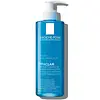What's inside
What's inside
 Key Ingredients
Key Ingredients

 Benefits
Benefits

 Concerns
Concerns

 Ingredients Side-by-side
Ingredients Side-by-side

Water
Skin ConditioningSodium Laureth Sulfate
CleansingOlive Oil PEG-7 Esters
EmollientSodium PEG-7 Olive Oil Carboxylate
EmulsifyingCoco-Betaine
CleansingPotassium Lactate
BufferingPEG-120 Methyl Glucose Dioleate
EmulsifyingSodium Citrate
BufferingLactic Acid
BufferingLavandula Angustifolia Oil
MaskingGlycerin
HumectantSimmondsia Chinensis Seed Oil
EmollientRibes Nigrum Seed Oil
EmollientOrmenis Multicaulis Oil
MaskingChamomilla Recutita Flower Oil
MaskingGlycyrrhiza Glabra Root Extract
BleachingCarum Petroselinum Seed Oil
MaskingMethylchloroisothiazolinone
PreservativeMethylisothiazolinone
PreservativeLinalool
PerfumingLimonene
PerfumingWater, Sodium Laureth Sulfate, Olive Oil PEG-7 Esters, Sodium PEG-7 Olive Oil Carboxylate, Coco-Betaine, Potassium Lactate, PEG-120 Methyl Glucose Dioleate, Sodium Citrate, Lactic Acid, Lavandula Angustifolia Oil, Glycerin, Simmondsia Chinensis Seed Oil, Ribes Nigrum Seed Oil, Ormenis Multicaulis Oil, Chamomilla Recutita Flower Oil, Glycyrrhiza Glabra Root Extract, Carum Petroselinum Seed Oil, Methylchloroisothiazolinone, Methylisothiazolinone, Linalool, Limonene
 Reviews
Reviews

Ingredients Explained
These ingredients are found in both products.
Ingredients higher up in an ingredient list are typically present in a larger amount.
Coco-Betaine is the natural version of Cocamidopropyl Betaine. It is often derived from coconuts.
Coco-Betaine is a surfactant, meaning it helps remove dirt and oil from the skin.
Peg-120 Methyl Glucose Dioleate is used to improve texture and stability of a product. It is sugar based and helps thicken a product.
Once applied, it also creates a thin film to trap moisture in. This helps keep your skin hydrated.
This ingredient is the polyethylene glycol ether of the diester of oleic acid and methylglucose. The 120 represents an average of 120 moles of ethylene oxide.
There is limited research on this ingredient, although it is considered safe to use in skincare products.
Learn more about PEG-120 Methyl Glucose DioleateSodium Laureth Sulfate (SLES) is a foaming, cleansing, and emulsifying ingredient. It is created from palm kernel oil or coconut oil. SLES is not the same as sodium lauryl sulfate. It is much milder and less likely to irritate.
SLES helps create foam in personal products. It also prevents ingredients from separating, helping to elongate the shelf life.
Sodium Laureth Sulfate is a type of sulfate. It can be drying. We recommend speaking with a professional about using this ingredient if you have concerns.
Learn more about Sodium Laureth SulfateWater. It's the most common cosmetic ingredient of all. You'll usually see it at the top of ingredient lists, meaning that it makes up the largest part of the product.
So why is it so popular? Water most often acts as a solvent - this means that it helps dissolve other ingredients into the formulation.
You'll also recognize water as that liquid we all need to stay alive. If you see this, drink a glass of water. Stay hydrated!
Learn more about Water